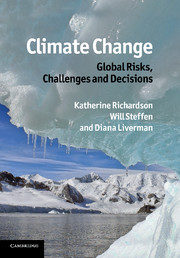Book contents
- Frontmatter
- Contents
- Writing team
- Foreword
- Preface
- List of acronyms and abbreviations
- Part I Climatic trends
- Part II Defining ‘dangerous climate change’
- 5 The impact of climate change on human societies
- 6 Impacts of climate change on the biotic fabric of the planet
- 7 Tipping elements: jokers in the pack
- 8 Linking science and action: targets, timetables and emission budgets
- Part III Equity issues
- Part IV Mitigation and adaptation approaches
- Part V Meeting the challenge
- Index
- Plate section
- References
6 - Impacts of climate change on the biotic fabric of the planet
Published online by Cambridge University Press: 04 April 2011
- Frontmatter
- Contents
- Writing team
- Foreword
- Preface
- List of acronyms and abbreviations
- Part I Climatic trends
- Part II Defining ‘dangerous climate change’
- 5 The impact of climate change on human societies
- 6 Impacts of climate change on the biotic fabric of the planet
- 7 Tipping elements: jokers in the pack
- 8 Linking science and action: targets, timetables and emission budgets
- Part III Equity issues
- Part IV Mitigation and adaptation approaches
- Part V Meeting the challenge
- Index
- Plate section
- References
Summary
‘The world that is bequeathed to us is, in our hands and in our time, being unmade … the future complexity of life – our potential gift to the future – is being eradicated’
Biodiversity represents the fabric of life itself. It is comprised not only of numbers of species, but also includes the variety of all life forms and their genes as well as the communities and ecosystems of which they are a part. The consequences of climate change for biodiversity are potentially profound.
Many acknowledge the importance of biodiversity in its own right, without any consideration of utilitarian value. However, biodiversity also provides the underpinning of the ecosystem services on which human societies are ultimately dependent. Without well-functioning ecosystems we humans, as a biological species, could not exist.
Even before anthropogenic climate change became a significant issue, biodiversity has been in decline in many parts of the world. The reasons are almost entirely linked to human numbers, economic activity and resource use; the proximate causes include landscape modification and conversion, direct predation (i.e. hunting and fishing), introduction of alien species, extraction of water resources, and application of excess nutrients. Climate change now represents an additional stressor, usually interacting with the already existing stressors in complex ways. The acceleration of biodiversity decline with climate change, and the consequent further degradation and loss of ecosystem services, provides important information to inform the discussion of what constitutes dangerous climate change.
- Type
- Chapter
- Information
- Climate Change: Global Risks, Challenges and Decisions , pp. 134 - 162Publisher: Cambridge University PressPrint publication year: 2011



